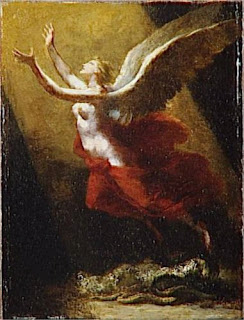We conclude our overview of Pierre-Paul Prud'hon (1758--1823) with this, one of his most haunting works, The Soul Breaking the Ties That Bind It to Earth. It is one of two paintings left unfinished at the time of Prud’hon’s death, and is a moving testament to his final years of pain, regret and dreams of reclamation.
This painting, one of the largest Prud’hon ever created (9.5 feet by 6.5 feet) is perhaps the least famous of the master’s works, but it may be among the most affecting. It was created after the suicide of Prud’hon’s lover, Constance Mayer, and it is not impossible to see where dreams of souls unleashed and free could not be far from the artist’s thoughts.
Prud’hon wrote, “What attaches me, alone in the world, to life? … Alas, I was attached only by the bonds of the heart, only by feelings of affection. Death has broken them in what was dearest to me … What do I have left to replace this happiness? … The emptiness of a soulless life, an emptiness without support, deep shadows without a glimmer of hope … Will death come quickly enough to save me from this unending pain and give me back the peace that I will find only there? … You, who should have followed me, you are no more – all of my thoughts, my impressions, and all that remains of my existence are bound to your tomb, to which all my wishes aspire.”
Though unfinished, this is a remarkable picture. The central figure is indeed complete, as any look at her luxuriant hair and the details of her wings would reveal. She reflects both golden and white sunlight, and the drapery around her heavenly form seems, to me, finished. The wings of the figure are particularly impressive – obviously painted with a brush called a ‘fan,’ alternately mixing and creating gradations of shade and color. The clearly visible brush strokes create a feathery impression, and one can well believe that these are the wings of an angel.
It is only at the bottom of the picture that Prud’hon probably has not finished his work – look at the study for the picture (see below) that Prud’hon did before painting the actual picture and you can see where his other ideas lay.
In the study for the picture, the figure’s feet are fettered to the earth with chains – missing in the finished picture. Also, the figure is more completely covered in a voluminous red robe, obscuring her legs and standing in contrast to the wings. It is possible that Prud’hon originally planned for the robe to be red in order to make the wings pop out. Also, the wings in the study are golden or yellow-tinted, as is the celestial light from above. For the finished picture, Prud’hon went with white robe, wings and celestial light – creating a purity of color to make the red of the serpent’s robe at her feet stand in starkest contrast.
There are at least eight initial studies for Soul extant, some drawings or cartoons, others mini paintings. I think the body language of the study shown here is, in its own way, more striking than that of the finished picture. The figure in the finished picture has a cool composure, a chilly passion that allows us to believe that this soul is indeed unfettered. How different from the study, where the body is clearly still of this earth and, in some degree, still in pain. It is almost as if each iteration brought the figure (and Prud’hon) closer to some kind of peace before the work was actually completed.
Prud’hon’s idea of a religious picture is consistent with his Age of Enlightenment. While the figure represents the soul, there is no Christian iconography on hand – in fact, the figure seems bathed in the light of Truth rather than the light of heaven. And while it’s unknown whether he began the picture before or after Mayer’s suicide, the picture clearly is a more personal one to Prud’hon because of the tragedy.
How much solace can an artist receive through his work? It seems to your correspondent that sometimes artists work in an exalted state of grace, as if receiving guidance from the spheres. It may not last long, but this finger of grace can transform the most base tragedy into a shared and moving experience. I like to think that the image of The Soul Breaking the Ties That Bind It to Earth was on Prud’hon’s mind when he closed his eyes that last, final time.


No comments:
Post a Comment